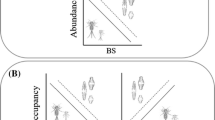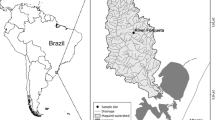Summary
Environmental size, as measured by cross-sectional area of the inhabited streams, and population density of Oxytrema proxima are related by the power function Y=8.074X -0.584, where Y=population density and X=cross-sectional area of the stream. Relationships were also found between maximum size and biomass and cross-sectional area, but maximum size and biomass were more closely related to population density by the equations Y=8.832X -0.064 (Y=maximum individual size, X=density) and Y=6.730X 0.459 (Y=biomass (total live weight), X=density). This is interpreted as evidence that environment size acts directly on density, which in turn produces effects on maximum size, total live weight, and to a lesser extent mean size. The inverse relationship between population size and environment has not been previously reported. It is clear that in this case this distribution and abundance of O. proxima are closely related, and that this can be so when populations disperse extremely poorly as well as extremely well. This must mean that dispersal is secondary in importance to population stability as an influence on distribution and abundance.
Similar content being viewed by others
References
Andrewartha, H. G., Birch, L. C.: The distribution and abundance of animals. Chicago: Chicago University Press 1954.
Birch, L. C.: The role of weather in determining the distribution and abundance of animals. Cold Spr. Harb. Symp. quant. Biol. 22, 203–215 (1957).
Carlander, K. D.: The standing crop of fishes in lakes. J. Fisheries Res. Bd. Canada 12, 543–570 (1955).
Conway, G. R., Glass, N. R., Wilcox, J. C.: Fitting nonlinear models to biological data by Marquardt's algorithm. (Ecology, in press.)
Foin, T. C.: The comparative dynamics of populations of the freshwater opersulate snail Goniobasis proxima. Ph.D. dissertation. Chapel Hill: University of North Carolina 1967.
Foin, T. C.: The distribution process in the freshwater prosobranch gastropod. Oxytrema proxima (Say) (Meosgastropoda: Pleuroceridae). (In Rev.)
Gerking, S. D. (editor): The biological basis of freshwater fish production. New York: Wiley & Sons 1967.
Glass, N. R.: A discussion of the calculation of the power function with special reference to respiratory metabolism in fish. J. Fisheries Res. Bd. Canada 26, 2643–2650 (1969).
Goodrich, C.: River barriers to aquatic animals. Nautilus 35, 1–11 (1921).
Klomp, H.: The dynamics of a field population of the pine looper, Bupalus piniarius L. (Lepidoptera: Geometridae). Advanc. ecol. Res. 3, 207–305 (1966).
Lynch, J. J.: The ecology of Lymnaea tomentosa in South Australia. Austral. J. Zool. 13, 461–473 (1965).
Rawson, D. S.: Some physical and chemical factors in the metabolism of lakes. In: Problems of Lake Biology. Publ. Amer. Assoc. Adv. Sci. 10, 9–26 (1939).
Reynoldson, T. B.: Population fluctuations in Ureceolaria mitra (Peritricha) and Enchytraeus albidus (Oligochaeta) and their bearing on regulation. Cold Spr. Harb. Symp. quant. Biol. 22, 313–328 (1957).
Stiven, A. E., Walton, C. R.: Age and shell growth in the freshwater snail, Goniobasis proxima. Amer. Midl. Nat. 78, 207–214 (1967).
Taylor, L. R.: Aggregation, variance, and the mean. Nature (Lond.) 189, 735 (1961).
Taylor, L. R.: A natural law for the spatial disposition of insects. 12th Internat. Congr. Entomol. 396–397 (1965).
Zar, J. H.: Calculation and miscalculation of the allometric equation as model in biological data. Bioscience 18, 1118–1120 (1968).
Author information
Authors and Affiliations
Additional information
Part of the Ph.D. dissertation of the senior author. Support from NASA predoctoral fellowship to the senior author, NSF grant GB-5039 to the junior author, and NIH grant ES 00101-01 to K.E.F. Watt is acknowledged.
Rights and permissions
About this article
Cite this article
Foin, T.C., Stiven, A.E. The relationship of environment size and population parameters Oxytrema proxima (say) (Gastropoda: Pleuroceridae). Oecologia 5, 74–84 (1970). https://doi.org/10.1007/BF00345977
Received:
Issue Date:
DOI: https://doi.org/10.1007/BF00345977




